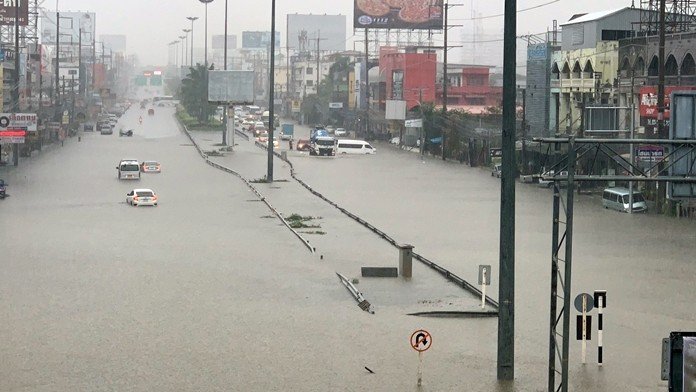The first heavy storm of the year thrashed Pattaya on Tuesday, deadlocking traffic and cutting huge swaths through newly rebuilt Pattaya Beach.
Two hours of torrential rain April 2 filled all the city’s major arteries with so much water, only large tour buses could move.

The flood runoff ran a meter deep on parts of Sukhumvit Road with police officers trying their best to get motorbikes and cars moving again.
On Soi Khao Noi through the railway-parallel road to Soi Khao Talo, flooding reached 50 centimeters, with vehicles forced to turn back before becoming stuck.
Numerous homes were damaged in Eakmongkol 4/3 Village on Soi Khao Talo 5, with water rushing into homes and submerging cars and motorbikes.
Resident Lan, 50, said the village is not connected to city sewers and has no way to quickly drain water. It’s also a low-lying area of East Pattaya, so the floods run deeper there.
He called for assistance from Nongprue Subdistrict, which has jurisdiction over the area.
Likewise, parts of Third Road, Soi Buakhao and Beach Road became impassable.
All that water has to go somewhere and, as it always does, it ends up washing over Beach Road and onto Pattaya Beach. The difference now, however, is that the shoreline has had a 600-million-baht facelift, so the damage caused by the torrents of water hurts even more.
Pattaya’s sewage system was designed to carry at most 80,000 cubic meters of water and waste simultaneously. At those levels, sewage constitutes only about 30 percent of the total volume, meaning storm runoff can dilute it sufficiently before it reaches the sea.

With the city’s population explosion, however, up to 120,000 cu. meters of liquid is being flushed into Pattaya’s pipes with half of that being raw sewage. While some can be cleaned at two sewage-treatment plants, large quantities of untreated wastewater ends up blackening the beach and sea.
Such was the case Tuesday, with Pattaya Bay turning black and deep trenches running through the new sand.
On Soi Khao Noi through the railway-parallel road to Soi Khao Talo, flooding reached 50 centimeters, with vehicles forced to turn back before becoming stuck.






